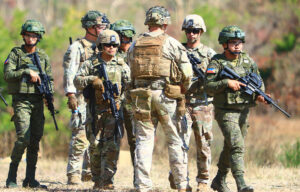THE PHILIPPINES and the US will stage more than 500 joint military engagements in 2026, ranging from large-scale combat drills to naval patrols and subject-matter exchanges, in what both sides describe as their most extensive defense cooperation plan to date.
The activities were finalized during the Mutual Defense Board-Security Engagement Board meeting in Hawaii, co-headed by Armed Forces of the Philippines (AFP) Chief of Staff General Romeo S. Brawner, Jr. and US Indo-Pacific Command chief Admiral Samuel John Paparo, Jr. Both signed the so-called “8-star memo,” a document outlining next year’s engagements.
“Both leaders renewed their commitment to deepened cooperation and interoperability to bolster deterrence in the Indo-Pacific region and achieve peace through strength,” the US Indo-Pacific Command said in a statement on Tuesday. “These collaborations foster sustained interaction between both militaries and enhance operational readiness.”
Among the key activities approved was the annual Balikatan (shoulder-to-shoulder) exercise, which has evolved into Southeast Asia’s biggest combat rehearsal. Recent iterations have brought in more troops, advanced missile systems, amphibious landing craft and complex warfighting scenarios designed to simulate modern conflict.
Philippine and US officials said the expanded scale reflects a growing emphasis on preparing for high-end warfare and enhancing interoperability between the two allies’ armed forces.
Manila and Washington are bound by their 1951 Mutual Defense Treaty, which obliges both to come to each other’s aid in case of an armed attack in the Pacific, including the South China Sea.
Security cooperation has intensified under President Ferdinand R. Marcos, Jr., who has taken a firmer stance against Beijing’s sweeping maritime claims compared with his predecessor.
The South China Sea remains a volatile flashpoint. China asserts control over almost the entire waterway through its so-called nine-dash line, overlapping with the exclusive economic zones of the Philippines, Vietnam, Malaysia and Brunei.
A 2016 ruling by the Permanent Court of Arbitration in The Hague voided China’s claims, but it has rejected the decision and maintains a strong naval and coast guard presence in contested areas such as the Spratly Islands and Scarborough Shoal.
The US Indo-Pacific Command noted that the Philippines’ holding of joint naval drills with allies in the disputed waters has been a “key success” this year. “These events are essential in ensuring freedom of navigation and improving interoperability.”
Philippine Navy spokesman Rear Admiral Roy Vincent T. Trinidad said the country is looking to “regularize” its maritime cooperative activities (MCA) with foreign navies. These activities, he added, have proven to affect China’s behavior in contested waters.
“For every MCA, there has been a noted change in the actions of the Chinese Coast Guard and the People’s Liberation Army-Navy,” he told a media briefing. “On the frequency, they will be increasing.”
He said the Philippines held only three activities in 2023 but managed to conduct 11 in 2024.
“This year alone, and we’re only two-thirds into the year, we already had around 10 or 11,” he said. “The details and scope of the exercises have also increased in magnitude and complexity.”
The steady growth of these activities shows that the Armed Forces of the Philippines is “now prepared to plug and play with modern militaries,” Mr. Trinidad said.
For Washington, the Philippines has become a critical partner in the Indo-Pacific, not only for defending mutual treaty obligations but also for building a coalition of states committed to upholding international law at sea.
The Marcos administration has welcomed the stronger military partnership, allowing greater US access to Philippine bases under the Enhanced Defense Cooperation Agreement (EDCA), including sites near Taiwan and the South China Sea.
The scheduled 500-plus activities for 2026 mark a significant expansion of the alliance, designed to demonstrate readiness and deter aggression at a time when regional security threats are rising. — Kenneth Christiane L. Basilio
